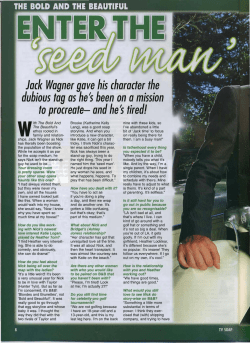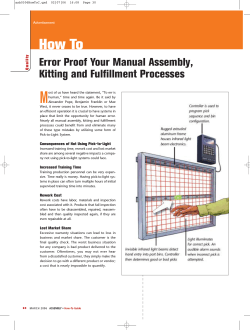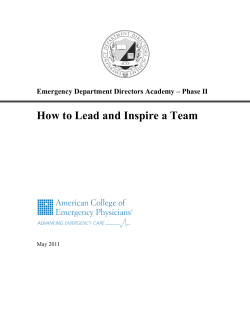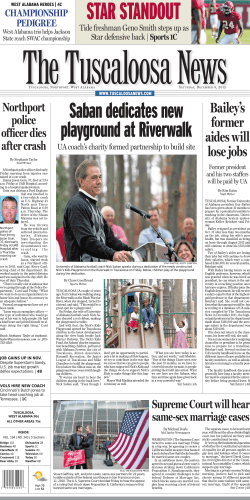
How to Make Team Building Work Learn how Leading Effective Teams
How to Make Team Building Work Learn how Leading Effective Teams can bring measurable success Tweeting? Please mention: #teambuilding (800) 263-6317 or (805) 690-5753 For More Info / To Register / To Access Archive: Search “Webinars” or “On Demand” at TrainingIndustry.com (800) 263-6317 or (805) 690-5753 • Owner and Chief Consulting Officer for Catalyst Team & Leadership Consulting. • Designs and delivers training programs for small businesses to the Fortune 500 in five continents. • Published expert in the field of team and leadership development including Interviews and articles in American Executive Magazine, Training & Development Magazine, American City Business Journal, and numerous White Papers about the use of measuring in team effectiveness. Nicholas (Nick) D. Conner info@catalyst-tbw.com 508-359-1792 On a personal note Nick is an avid BBQ Smoke Master, a poor golfer and a Black Belt in Kung Fu but insists, “I am a really nice guy”. The MASTERS Of Success ken BLANCHARD nick CONNER jack CANFIELD john CHRISTENSEN Thoughts for today’s discussion: Are you aware of your team’s wellness or health when it comes to teamwork? Do you have the ability to measure and track the development of your teams over time? Are you able to diagnose and prescribe development opportunities? The concept of “Teamwork” is a fairly simple one. It is the lack of understanding the dynamics of teams. It’s the execution that is so difficult because it takes high levels of discipline and persistence. We unknowingly or knowingly slip into our old ways of doing things. What is a Team? Team A Team is a group of people with diverse skills whose members struggle for shared aspirations (a common goal) with measurable performance and joint accountability. Corporate Salute Work Group A group of people with diverse skills whose members struggle for shared aspirations individual (a common goal) with measurable performance and joint accountability. individual Teamwork Doing more, efficiently and faster Team building 101 Team Stages of Development Dr. Bruce Tuckman 1965 TRANSFORM PERFORMING NORMING REFORM STORMING FORMING The Tuckman Model Poll Question for the group: Recently, which contributing factor has impacted team development the most? 1 2 3 4 5 Change/uncertainty Personalities of the team members History/culture of the organization Lack of strategy/direction The Euro CHANGE Team building 101 Team Stages of Development Dr. Bruce Tuckman 1965 PERFORM THE TEAM PERFORMING NORMING REFORM STORMING FORMING The Tuckman Model When is the best time to do team building? Why team training? Why Teamwork? Murphy Model Murphy Model NEW JOB ADVANCEMENT PURPOSE $$$$$$$$$$$$$$$ 60% $$$$$$$$ 20% $ •Engagement •Autonomy •Being part of something •The chance to get better •Self directed •Recognized •Belonging Self Actualization Self esteem Psychological needs Safety needs - Comfort Basic needs - Survival $$$$$$$$ high performance $$$$$$ moderate performance $$$ low performance 0 2 4 6 8 10 $$$$$$$$ high performance $$$$$ moderate performance $$$ low performance 0 2 4 6 8 10 Murphy Model •Autonomy •Mastery •Purpose Why team training? Why Teamwork? MOTIVATION MOTIVATION Poll Question for the group: Which stage of development from Tuckman’s Model do teams commonly skip over? 1 2 3 4 5 Forming Storming Norming Performing Misinforming Team building 101 Team Stages of Development Dr. Bruce Tuckman 1965 PERFORMING NORMING STORMING FORMING The Tuckman Model Why team training? Why Teamwork? Reason Two through·put ͞ ͝ /ˈTHrooˌpo ot/ Noun The amount of material or items passing through a system or process on its way to the customer or point of sale. Synonyms: output The Goal A process of ongoing improvement Eliyahu M. Goldratt Throughput After sales service 4. Shipping or delivery of product or service 3. Build product or service 1. Sales promises product 2. Strategize on designing, product or service prof·it /ˈpräfit/ Noun A financial gain, esp. the difference between the amount earned and the amount spent in buying, operating, or producing something. Throughput I SENT THAT EMAIL…I NEVER GOT IT!! THIS REWORK COST US FOUR WEEKS. SHIPPING DELAYED After sales service WHERE’S IT GOING? Where’s the pink form? You need the pink form The client wants to know where this is. Delivered when?!! 4. Shipping or 1. Sales promises delivery of THEY’RE IDIOTS product product or service YOUR FAULT! DON’T TELL ANYONE, SEND IT BACK BUT I HEARD… She’s not communicating on purpose. I don’t trust those guys. They’re setting us up for Failure! Specs are wrong. She’ll just have to wait. I cant believe D you promised that! E 2. Strategize on 3. Build product or L designing, product service or service A Why weren’t my Y people brought in on this? Why aren’t my E ideas being used? D Won’t work. Which flips and decrease our margins Increased cost to create throughput So we work harder and make less $ $ $ $ $ $ $ $ $ Lack of Communication Power struggles Rework Disrespect Ego Rework Not aware of accumulative impact actions decisions and behaviors will have on the over all goals Rework $ $ $ Why team training? Why Teamwork? Through put = Margins = Profit Why team training? Why Teamwork? Motivation and Bottom Line Why team training fails Why Training loses it’s impact 1. Content and activities are not relevant. One size fits all, off the shelf programs are not tailored to your needs. 2. Lack of strategy, planning or road mapping applications and change. 3. Lack of follow up HAVE YOU MADE IT MEASURABLE AND SUSTAINABLE 5.000 4.500 4.000 3.500 Role Clarity 2.70 3.000 Vision Communication 2.50 2.500 2.000 2.10 1.500 Trust 2.00 1.000 0.500 0.000 1 S e r 2 3 4 5.000 4.500 3.9 4.000 3.500 3.78 Dependency 3.000 Conflict 2.500 2.90 2.000 Cohesion 1.500 1.90 1.000 0.500 Synergy 0.000 1 S e r 2 3 4 5.000 4.500 3.98 4.000 3.75 3.10 3.500 Role Clarity 3.000 3.20 Vision 2.70 Trust Communication 2.50 2.500 Survey 1 Survey 2 2.000 2.10 2.00 1.500 1.000 0.500 Survey 2 0.000 1 2 Survey 1 3 4 Pre & Post-Program Comparison 5.000 4.500 3.90 4.000 3.78 3.500 Dependency 2.38 3.000 3.75 3.10 3.20 Cohesion Conflict 2.90 2.500 Survey 1 Synergy Survey 2 2.000 1.500 1.90 1.000 0.500 Survey 2 0.000 1 2 Survey 1 3 4 Making it relevant Define clear objectives; what are the desired needs and desired outcomes (future state). Hold Facilitator interviews with your key decision makers and even all the participants if possible. Use a measurement tool to determine your groups present state (level of trust, communication etc.) and for tracking development post program. Tailoring programs and training Learn as much about your organization as possible including your industry, history, events, culture and even your language. Begin with the end in mind. What does a successful program look like? Use data from measurement tools to determine appropriate activities, learning models and support tools. Strategy and action planning What are we doing on Monday morning as a result of our insights and what we learned. Be specific. For example, “we need to better communicate” is too vague. If you see a video of your team better communicating what would you see? Catch who, what and when when it comes to matters of resolution. This includes a champion/committee and time lines. Meaningful and fun What? So What? Now What? Why team training? Why Teamwork? Motivation and Bottom Line Why team training fails Lack of Relevancy Lack of Strategy Lack of Follow Up No Measurement POLL Question for the group: What, in your professional opinion, should be the most important aspect to a successful training program? 1 2 3 4 5 Strategy and application Measurement and assessment Fun and entertaining Good coffee Tailored or customized program It’s not my money. Knock yourselves out. Always, always has to be her idea. What ever! Hey, What’s for lunch? This will never work. I agree. Let’s do this. Yes, Sir! We’re on board. Leading Effective Teams Tannenbaum Schmidt Continuim Lewin and Lippitt 1938 Tannenbaum & Schmidt in 1973 Situational Leadership Hersey and Blanchard 1973 Johari Window Joseph Luft and Harrington Ingham in 1955 Q&A with Nick www.catalyst-tbw.com Team and Leadership Consulting nconner@catalyst-tbw.com 508-359-1792 Upcoming Webinars 6/18/13 Shifting Your Organization Toward Performance-centric Learning Systems 6/26/13 Using Measurement to Drive Impact & Effectiveness of Leadership Dev. 6/27/13 Communicate, Collaborate & Become more Productive Using Social Learning For More Info / To Register / To Access Archive: Search “Webinars” or “On Demand” at TrainingIndustry.com Executive Seminar Series Join our LinkedIn Group to continue this discussion! Learn more at TrainingIndustry.com Thank You On behalf of TrainingIndustry.com, thanks to: Today’s Speakers: Nick Conner Today’s Sponsor: Catalyst All of you for attending Questions or Comments? Please contact Nabeel Jaitapker: njaitapker@trainingindustry.com
© Copyright 2025





















